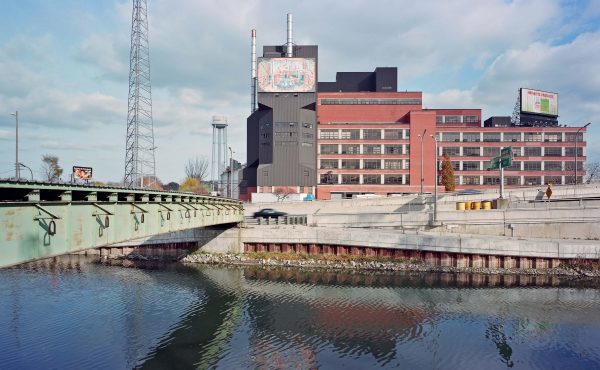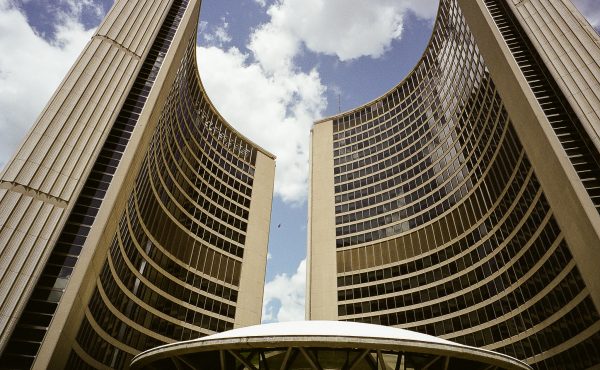This week, Spacing presents five excerpts from Straphanger, the new book by Montreal-based author Taras Grescoe. The book examines the success stories, challenges, and future hurdles of 14 transit systems from across the world, including Toronto, Montreal, and Vancouver.
![]()
TODAY: Toronto (last excerpt)
I’d always planned to end up in Toronto. After all, it was the city where I started.
I was born at the old Women’s College Hospital, near Queen’s Park station on the Yonge-University line, in 1966. At the time, my parents were renting a top-floor flat in a house on Lytton Boulevard, a short stroller’s push from Yonge Street; an auspicious first address for a newborn, it turned out, as it had belonged to one of the inventors of Pablum (his widow spoon-fed me the vitamin-rich baby mush, which may explain why I never developed rickets). When I was only four years old, my parents joined the exodus to suburbia, and we moved to a cookie-cutter bungalow on a curvy street in Burlington, twenty-five miles west along the shore of Lake Ontario from Union Station.
I used to wonder if this early exile from the city was the foundational trauma that led to my lifelong bias against subdivisions, but my Kodachrome-hued memories of Riverside Drive—of netting crayfish in the nearby creek, of walking to Frontenac Elementary School, and of pretending I was Bobby Orr in street hockey games—are for the most part fond, and at worst emotionally neutral. My parents tell me they bought the house as a short-term investment, but if they were hoping the suburbs would be a healthier setting than the city, they seriously misjudged Southern Ontario. Less than a mile from our carport were the multimillion-gallon storage tanks of the Oakville refinery, where British Petroleum was busy making jet fuel, and beyond a tiny stand of oaks known as Sherwood Forest Park lay the Queen Elizabeth Way—six lanes of rushing traffic that, in the days before emissions controls, must have created a formidable cancer corridor of leaded gas exhaust. My parents lasted two years in Burlington, before giving up on the land of loops-and-lollipops and bundling my sister and me onto a westbound train.
At a time when downtowns across North America were hollowing out, there was nothing exceptional about my parents’ move to the outer suburbs. But it turns out that what made the Toronto area unique in the waning years of the postwar baby boom was the way it was bucking the continent-wide trend toward city-sapping suburbanization. Toronto was the city that Jane Jacobs and her family, despairing of the future in Vietnam-era America, had chosen over New York, settling in the Annex, just one of many inner-city neighborhoods that have never given up their vitality. The city’s freeway revolt, led by University of Toronto professors and supported by Jacobs, put the kibosh on the Spadina Expressway, which was part of a larger plan to straitjacket the entire downtown with urban freeways. (The uprising came too late to spare the city the elevated Gardiner Expressway, a leprous eyesore that continues to sever Toronto from its waterfront.) While other cities were putting up district-killing high-rise concrete slabs, Torontonians were renovating old row houses in the central city. And thanks to a decades-long tradition of regional planning and governance, metropolitan Toronto still sprawls half as much as North American cities with comparable populations.
For much of the twentieth century, Toronto was also known as a model of efficient urban transit. The Toronto Transit Commission (TTC), which until the ’70s required no government subsidies at all, was generally considered a triumph for public ownership. Over half of the city’s workers still get downtown by commuter rail, streetcar, bus, or subway, and transport scholars continue to study the way the TTC extends the reach of its small but efficient two-line subway by using a brilliantly integrated network of feeder buses. While cities like Philadelphia may have potential for revival, Toronto has never questioned its urban birthright: the “City that Works,” as impressed visitors used to call it, has long been seen as a Mecca for urbanists, and a shining example of rational transportation planning.
Which is why, when I visit the city of my birth these days, I spend a lot of time shaking my head in sad wonder. In just over a decade, Toronto has lost its lead as a global model for well-planned regional growth, and the TTC is on its way to becoming a case study in how to quickly squander a hard-won legacy of decent transit. Vancouver, meanwhile, has easily outdistanced Toronto as the continent’s leading example of progressive transport planning, and even sprawling Calgary can now lay claim to more far-sighted municipal leadership.
When I planned this voyage, Toronto was going to be part of my itinerary; I figured Canada’s biggest city still had something to teach North America’s most mobility-challenged metropolises about smart urbanism. As my journey draws to an end, however, it is becoming clear that its real claim to fame is as a cautionary tale for other cities. In Toronto, the apposite question has lately become: How did a city that used to work so well end up so broken?
Excerpt taken from Straphanger © 2012 by Taras Grescoe. Published by HarperCollinsPublishers Ltd. All rights reserved.
photo & model by Chris McVeigh






6 comments
While I have enjoyed reading this series, this one is very disappointing, full of rhetoric and emotion with little to no factual information about today’s Toronto (maybe it is in the book but not in this excerpt). And the sentiment does not do justice to Toronto either. Yes, Toronto made a lot of mistakes over the past few decades, but as a whole it still has so much things right, it is still one of the most livable city in North America, and things are getting even better.
Wow, this expresses my sentiments exactly. If you scan old planning textbooks, especially in transportation, Toronto is heralded as a model city. If you look at planning books today, Toronto hardly rates a mention, with cities like Vancouver, Calgary, Portland, etc. getting most of the attention in North America. Having now lived in Vancouver for several years, and being a former Torontonian, I can say – without hesitation – that Vancouver has a far more progressive and workable transit system than Toronto does. Everything form the legibility of the maps, to the sustainable funding structure, the degree of regional integration, using an automated rapid transit system to its full potential (the way the TTC uses the Scarborough RT is analogous to buying a top of the line gaming computer to run Microsoft Word 97), and various affordability programs (postsecondary students pay a $30 monthly pass that’s good for the entire region) blows the TTC out of the water.
Inevitably, when I praise Vancouver’s transit system in TO, a Torontonian will spit out the old yarn about how “Toronto still has a higher ridership per capita than Vancouver”. This, of course, has nothing to do with the quality of service and everything to do with historical circumstance and the era in which the city was built. I would, by extension, not say that New York City has a more progressive transit system than Toronto because it has an even higher ridership per capita.
A final thought: even though it’s a surface judgment, and rather trivial, you can note the difference in quality between Translink and the TTC by the fact that the TTC had to install barriers to separate bus drivers from their customers after several nasty customer service incidents involving physical violence…while in Vancouver, people thank the driver when they exit the bus.
Kind of disappointed that with the negative opinion of the TTC, there wasn’t really any evidence given as to what is wrong. Not that we Torontonians don’t know what is wrong, but it would have been nice to have its drawbacks mentioned in order to backup the thesis.
I would love to care at all about Toronto’s urban environment, but it’s too heartbreaking when so few of its residents do. I made a final decision to give up caring about Toronto when a good friend, trained in planning and an urban Torontonian his whole life, told me that nobody would go to a pedestrian neighbourhood, because “where would they park their cars?”
I’ve lived in four cities: Toronto, Montreal, St. Catharines and Tokyo. Sadly, the two Ontario cities are the most similar: charmless and car-dominated. Though Tokyo is in another league with how inexhaustibly fascinating it is (as London, NY and a few others), central Montreal comes out the most livable. I have to return to Toronto from Tokyo, but I’ll stay in my neighbourhood for the most part since getting around the city only works by bike, and drivers would like to get away with running you off the road for it.
Vancouver’s bike network is also incredibly better than Toronto’s, while they have a relatively low (compared to Toronto) cycle ridership. Toronto’d much rather spend her millions on making the highways so perfectly smooth, rather than spend a few thousand and protect the lives of people who don’t just pollute the city, but contribute to it socially and culturally.
While I agree with the sentiments expressed in the author’s excerpt, I find myself becoming defensive too. I’m sure (I hope) there is lots more “information” in the book itself, but by reading the excerpts alone, the author’s remarks seem to be totally decontextualized from history and politics.
When I was living and working in Vancouver’s DTES a few years ago, I was on a neighbourhood walking tour and was shown all of the transit tracks that were paved over. At that time, Vancouver was just starting to build its Olympic transit line. The author doesn’t seem to consider these aspects: Vancouver is hardly a progressive transit City when it lets die and paves over its tracks in one generation and then pours public money into a new line only to satisfy the Olympic spending urge; moreover, there’s no discussion of the politics of spending public money on transit in preparation for the Olympics, while at the same time refusing public money for housing, which is badly needed, shipping homeless people out of the City, stealing Aboriginal land for highway construction, etc.
All of this is to say that while I’m on board for improving transit in Toronto, let’s not detach it from the greater historical and political context that it necessarily falls in.